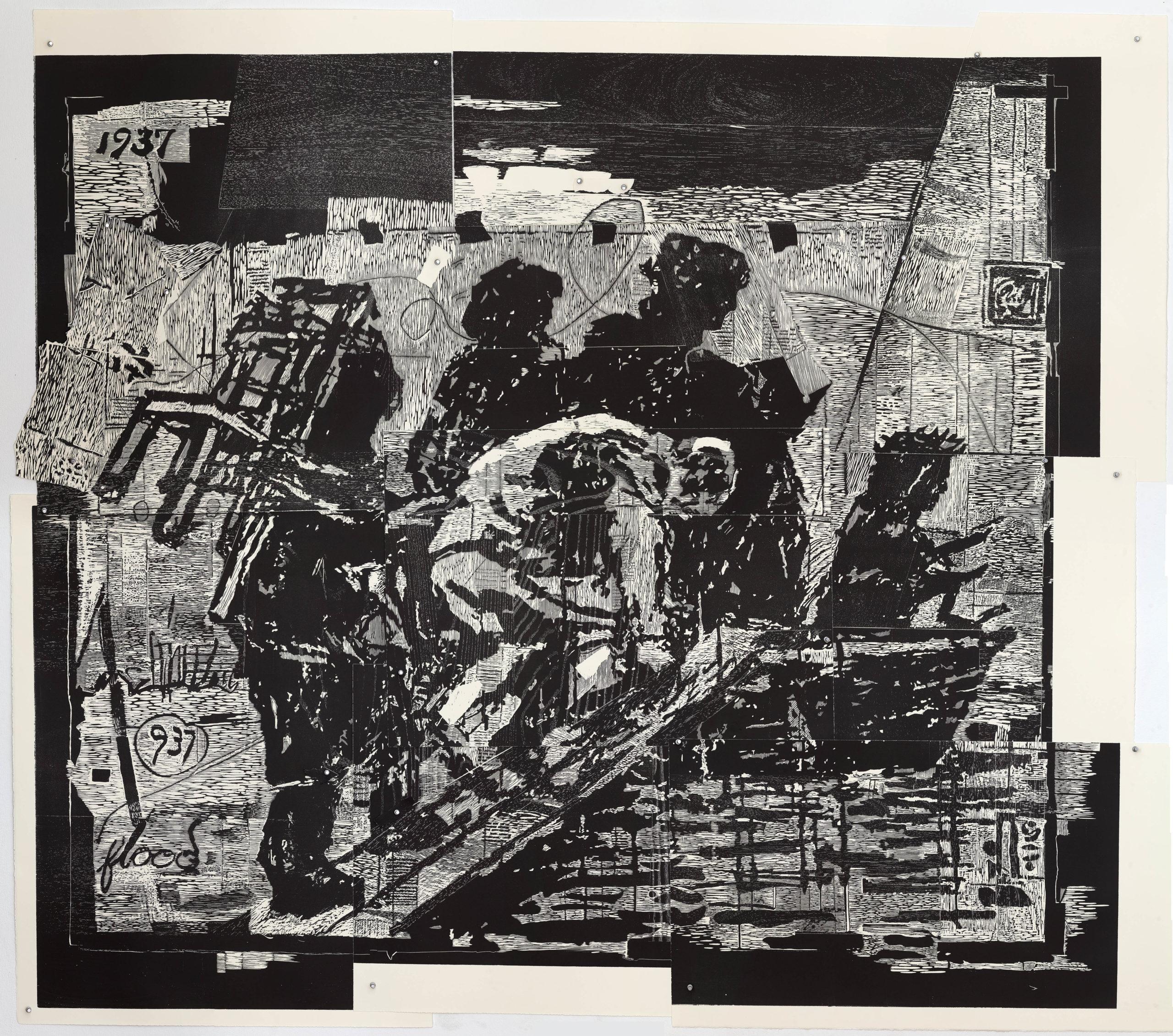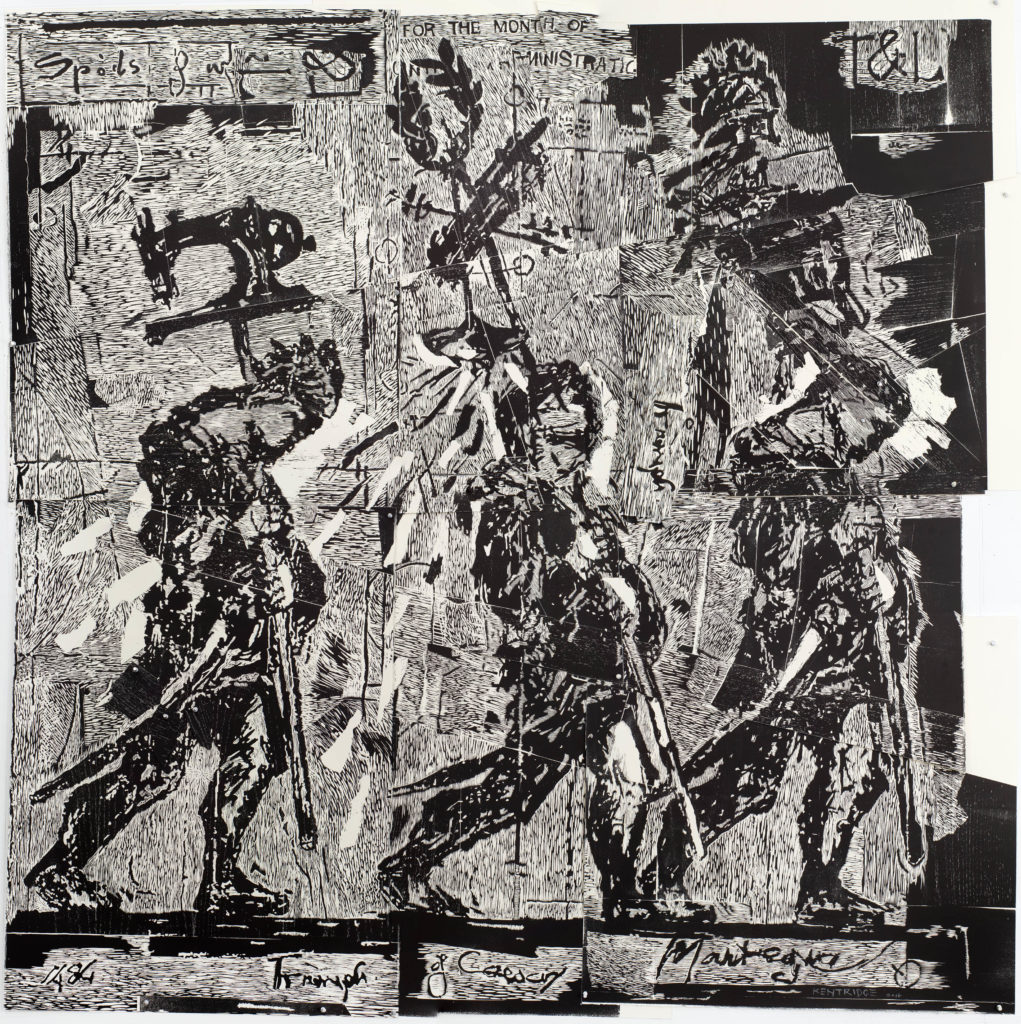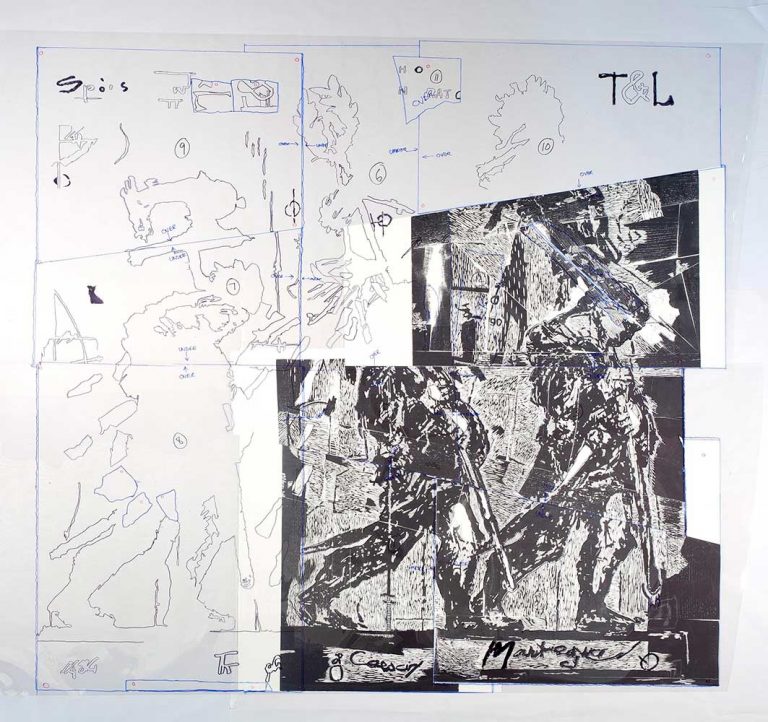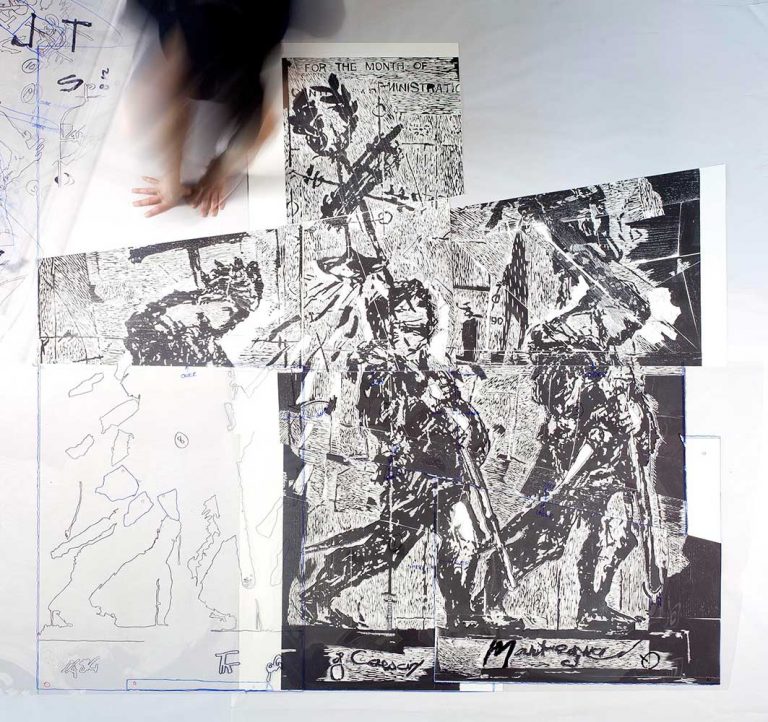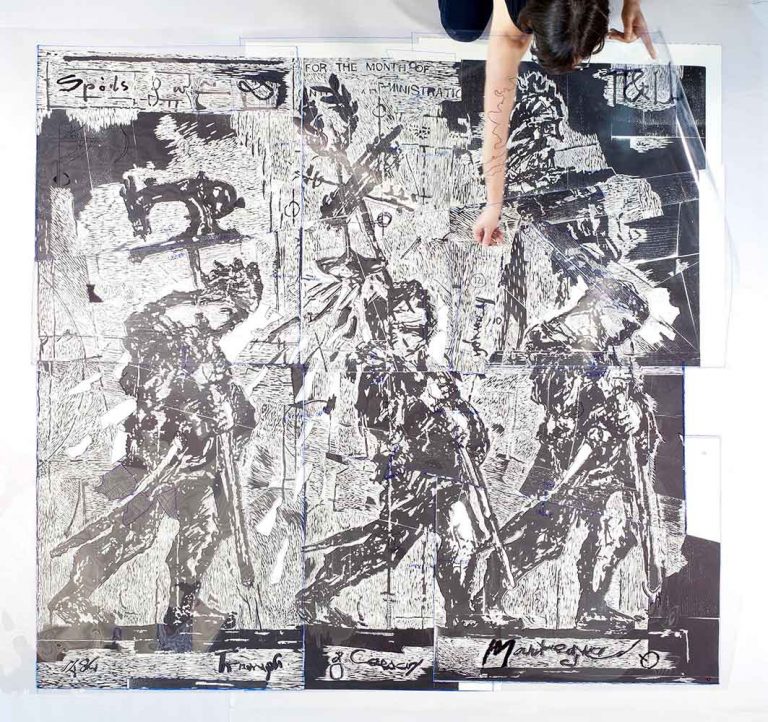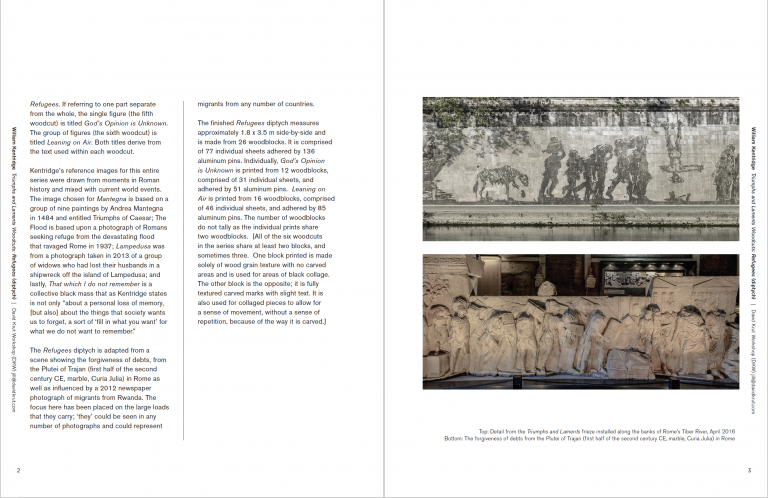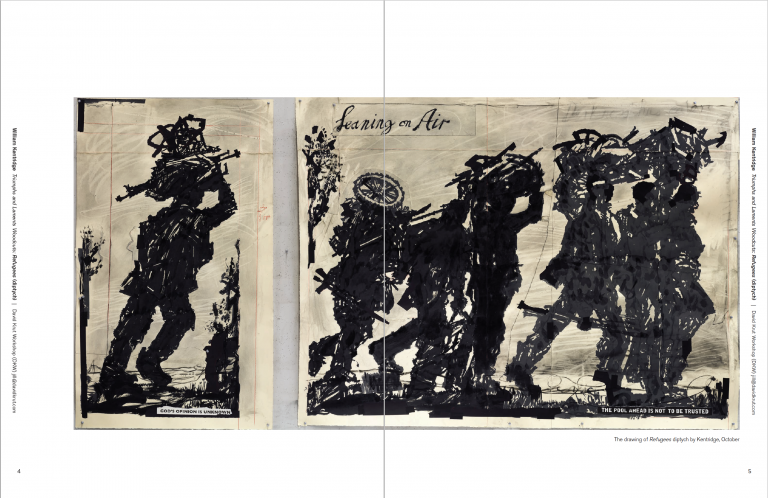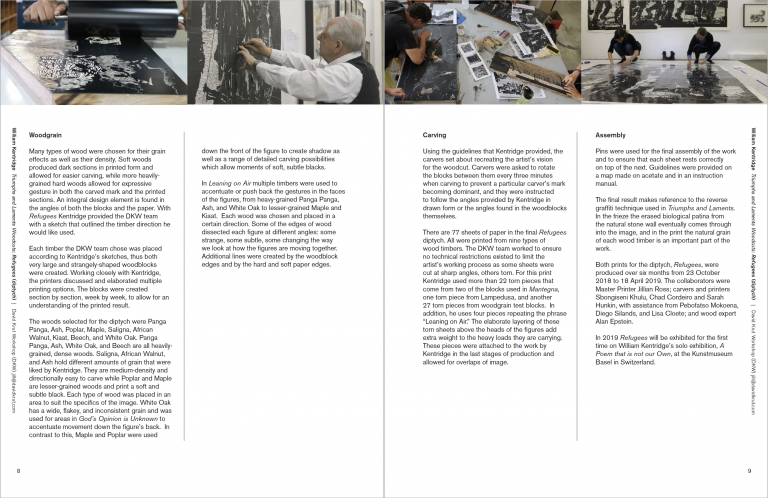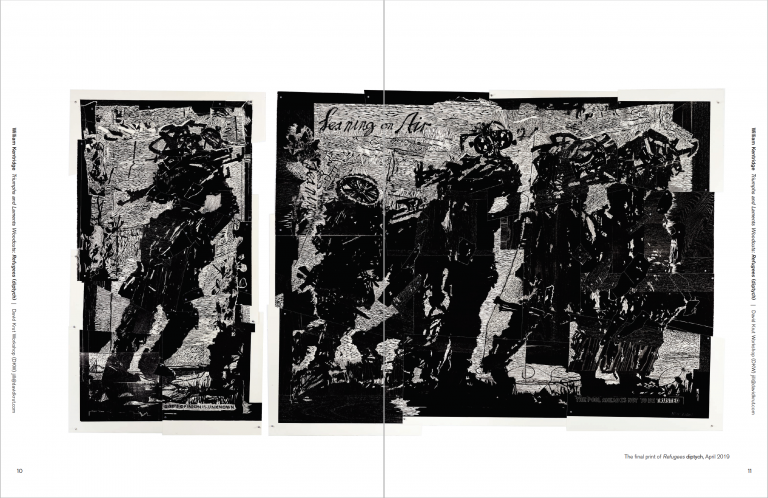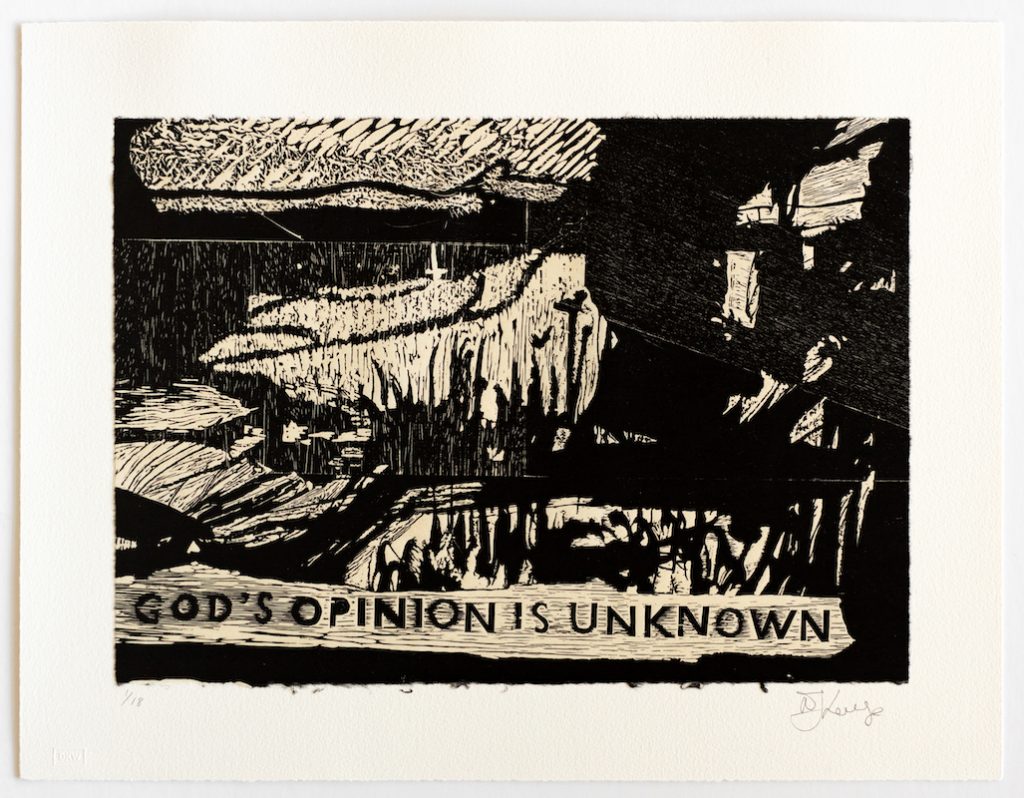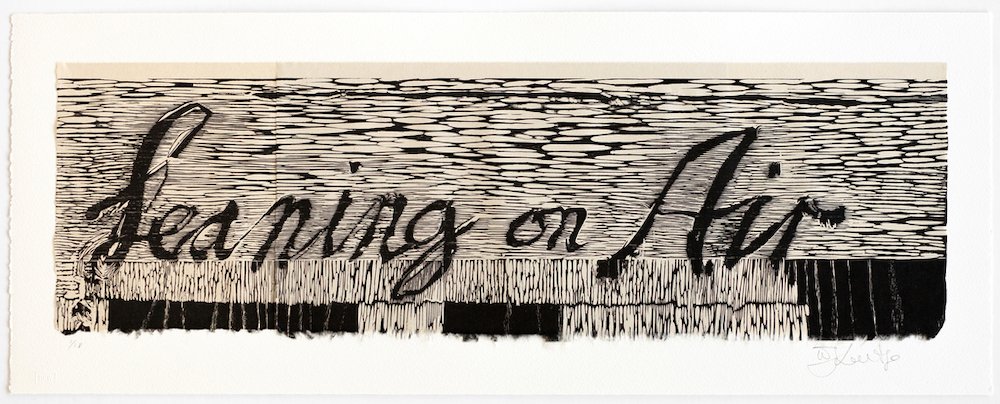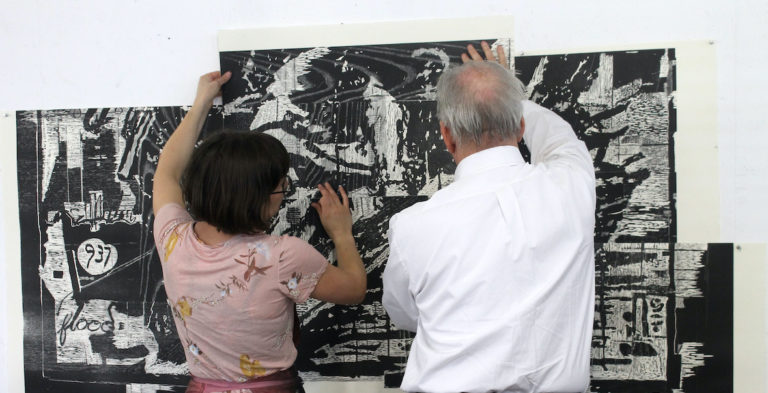William Kentridge | Why Should I Hesitate: Putting Drawings to Work Deichtorhallen Hamburg, © Henning Rogge, 23 October 2020 to 18 April 2021
William Kentridge
Triumphs and Laments Woodcuts
2016 - 2021
In early 2016 William Kentridge was at work on a monumental frieze to be installed along the banks of Rome’s Tiber River in April of the same year. The 550 meter work would be stenciled onto the wall of the river from Ponte Sisto to Ponte Mazzini. It would be called Triumphs and Laments and would consist of scenes from the cultural and political history of Rome from drawings that Kentridge had been preparing in his studio in Johannesburg for a number of years.
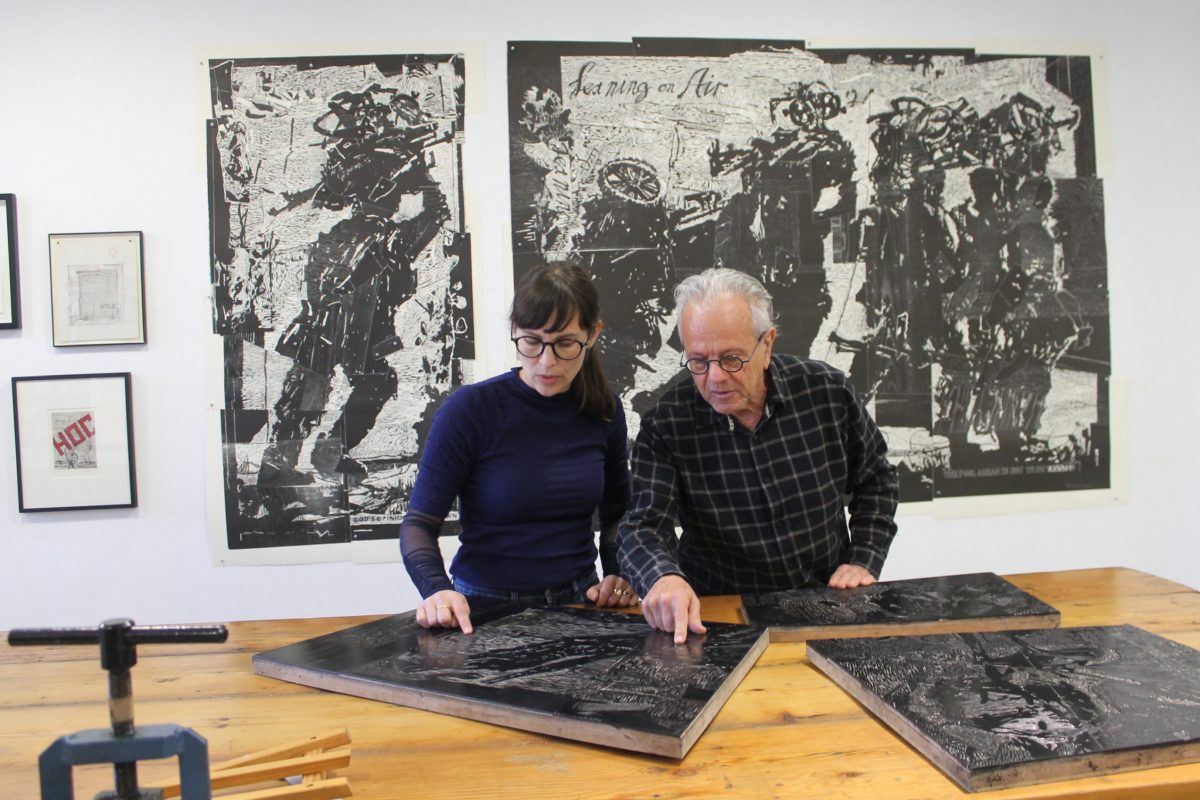
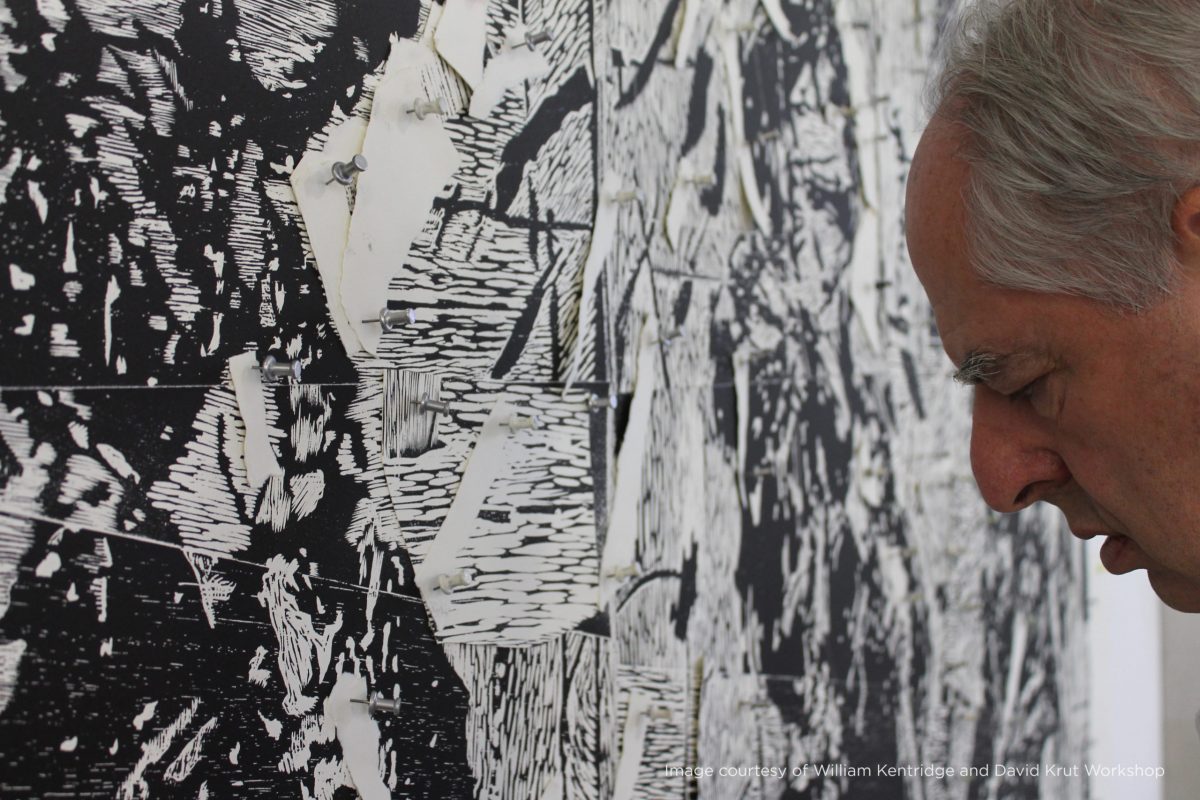

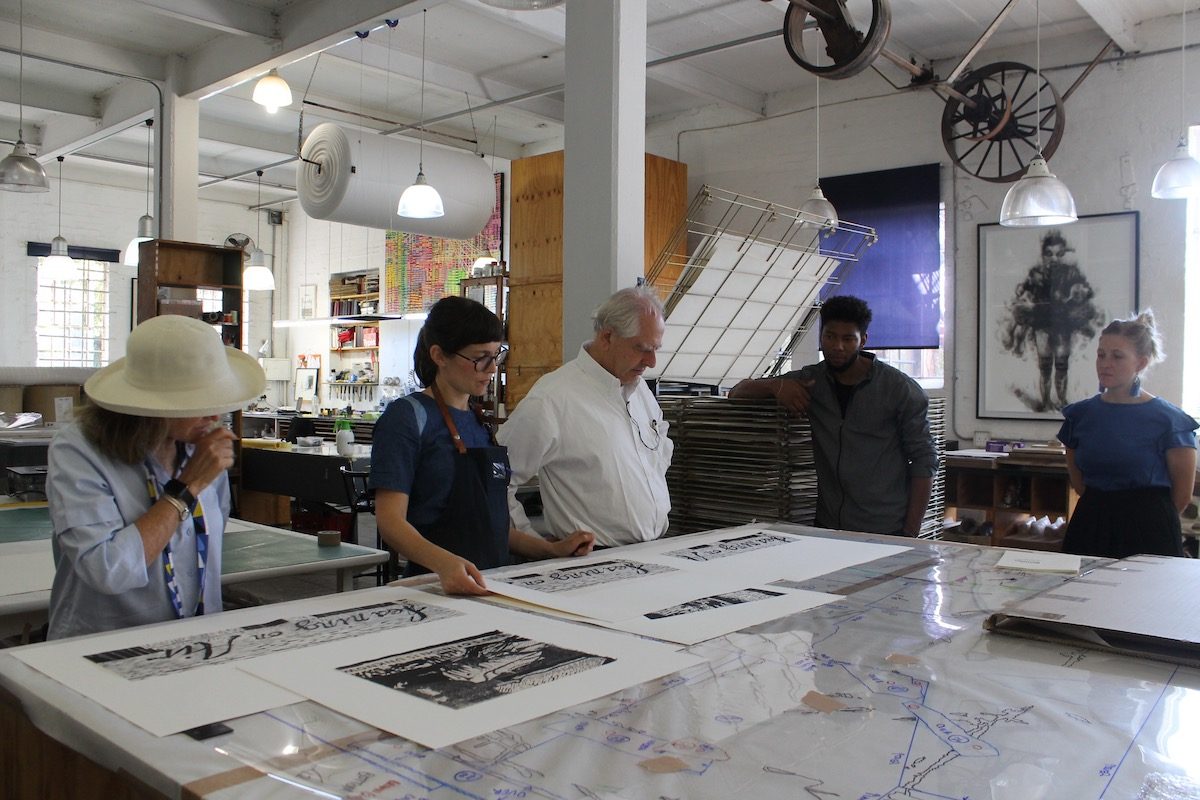
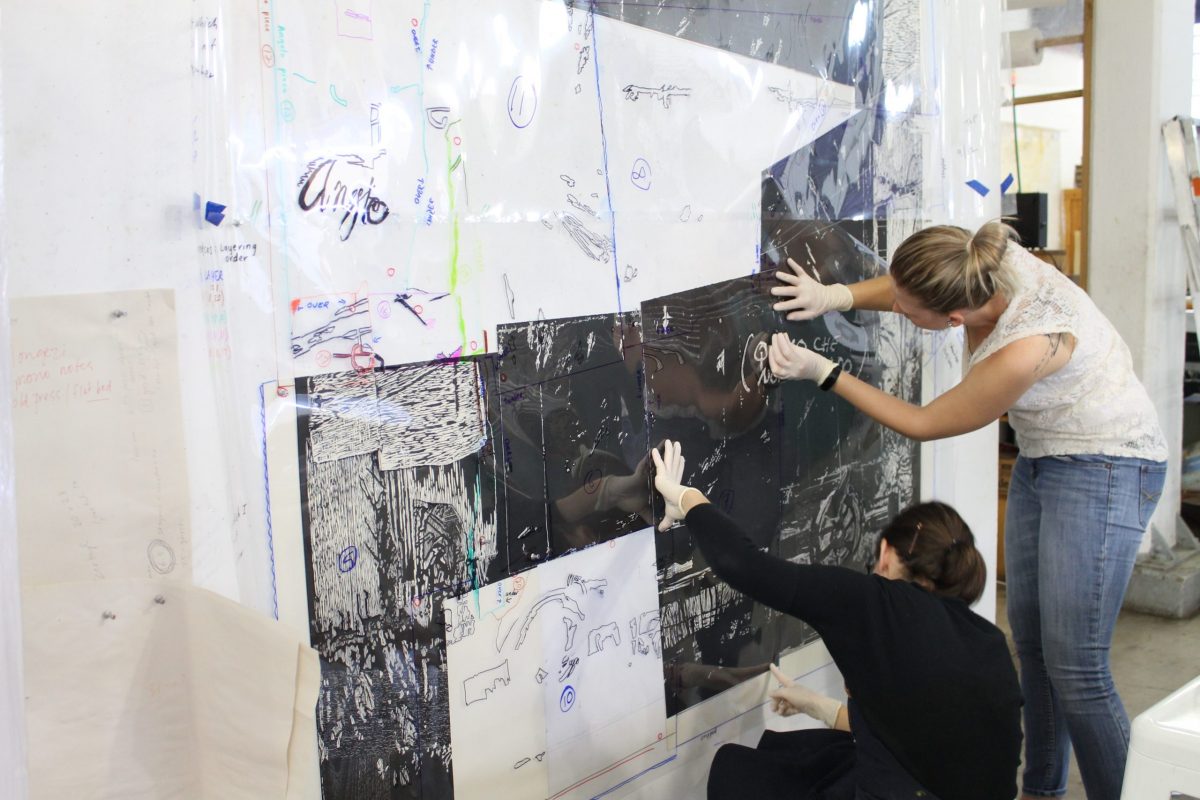
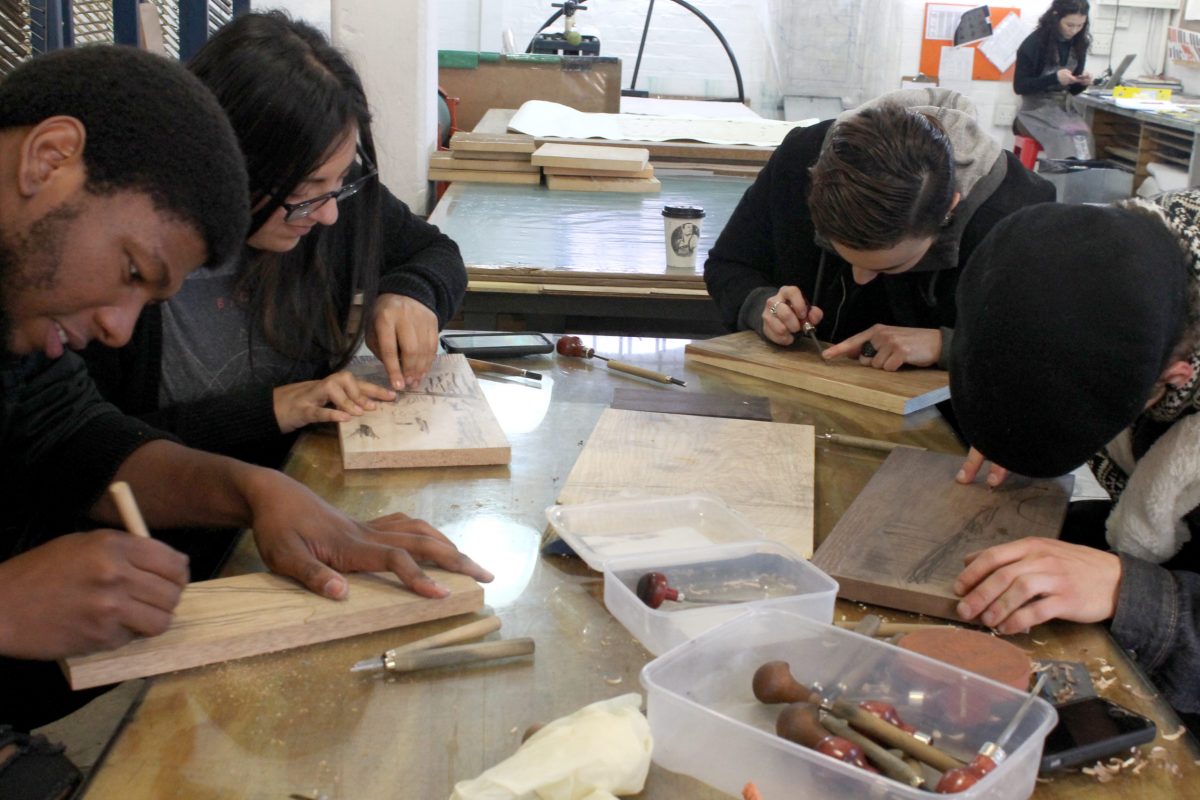
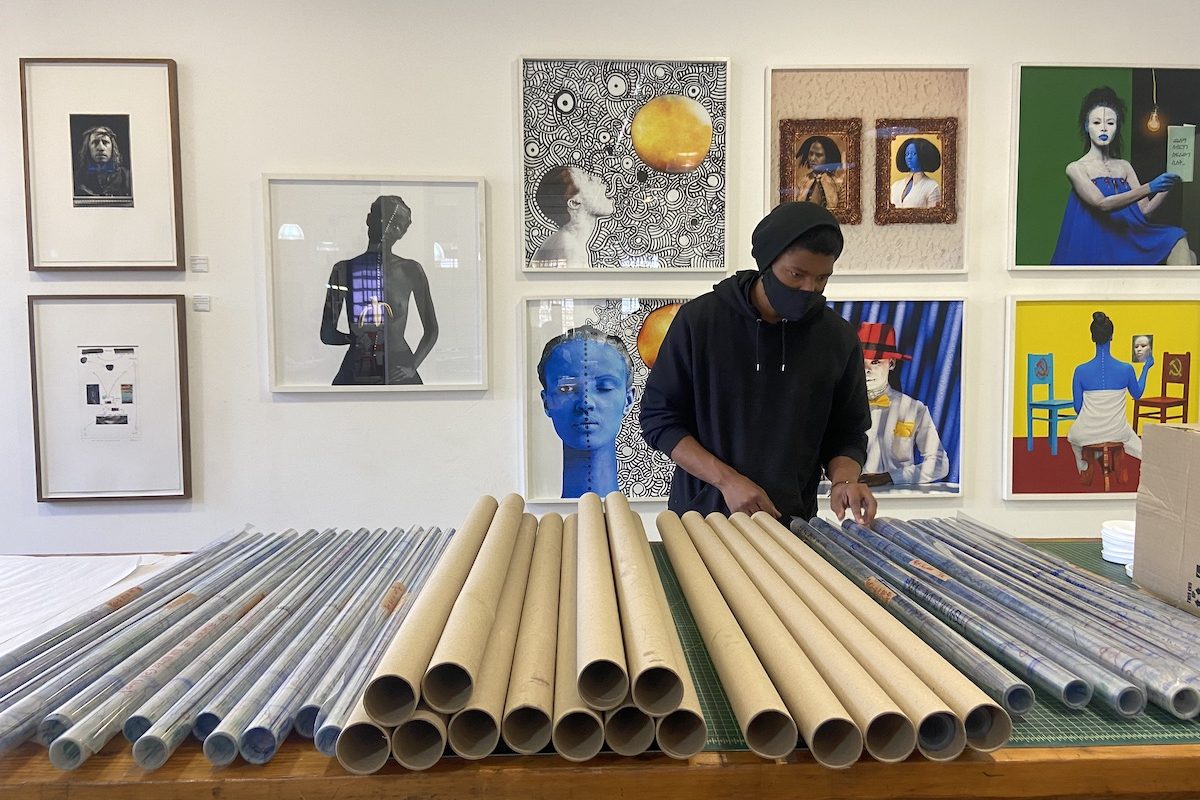
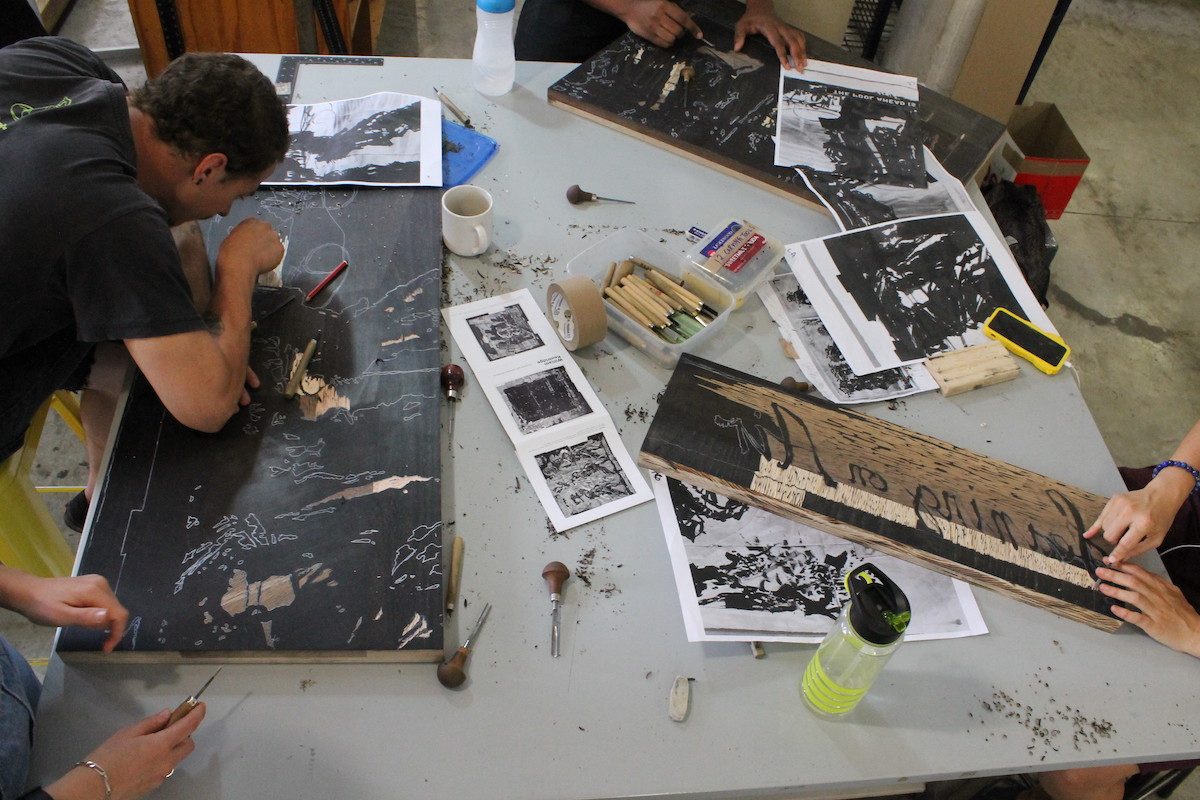
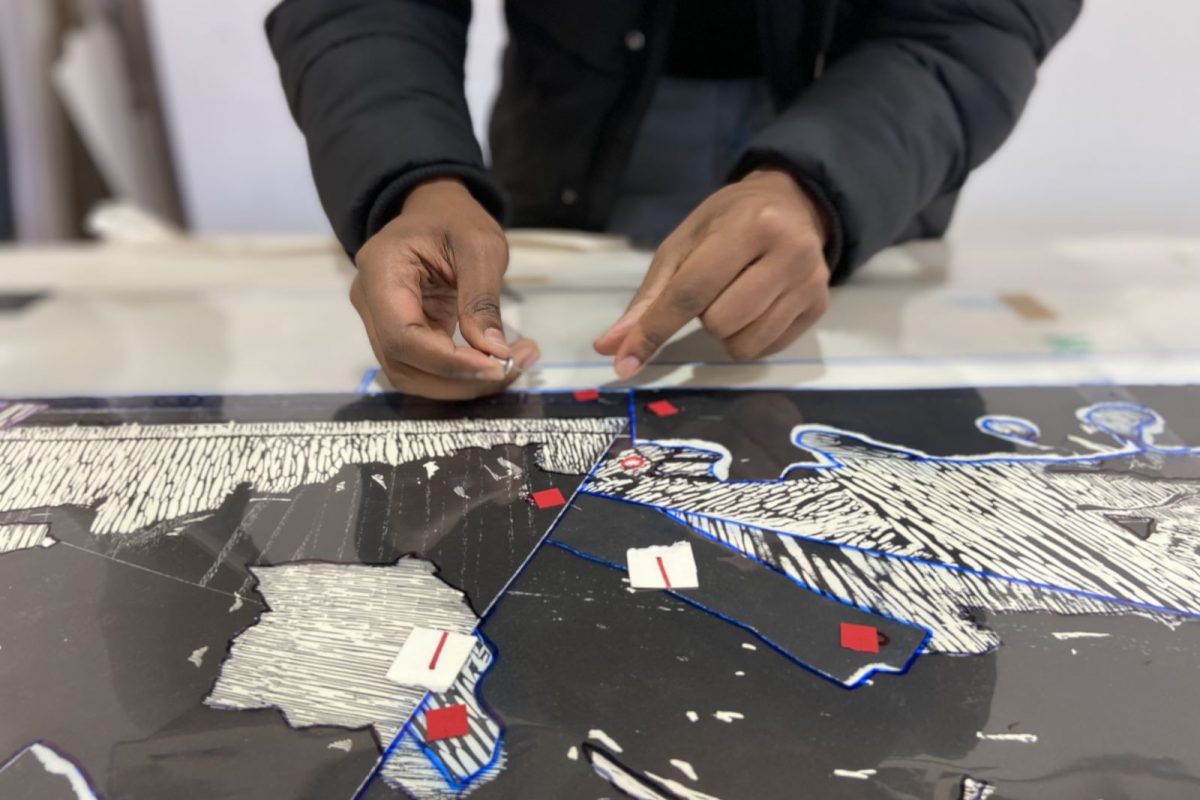
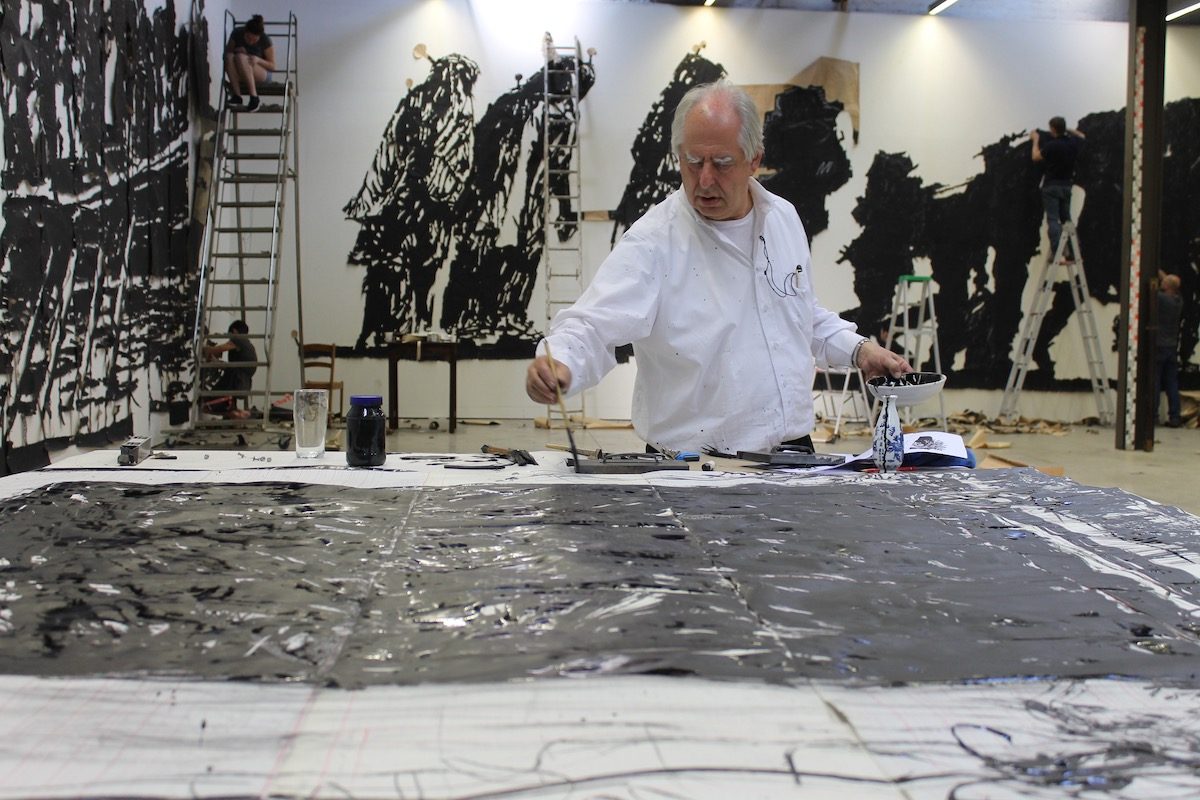
In January 2016 Kentridge also began discussions with a long-time collaborator, Master Printer Jillian Ross of David Krut Workshop (DKW), about using these drawings as the basis for a series of large woodcut prints. Ross and her assistants Sbongiseni Khulu and Chad Cordeiro began extensive tests on a grouping of three figures from the frieze as this would be their first woodcut project with Kentridge. Over the course of 2016, the printing team worked on creating and editioning the first two woodcuts in the series, Mantegna and The Flood. In January 2017 work commenced on the third image in the series, Lampedusa, and by October 2017 the fourth woodcut, That which I do not remember, was complete. Work began on the next two images simultaneously in October 2018. This is the first work in the series created in two parts. Collectively, the diptych is titled Refugees (1 God’s Opinion is Unknown; 2 Leaning on Air).
Kentridge’s reference images for this entire series were drawn from moments in Roman history and interleaved and overlaid with current world events. The image chosen for Mantegna is based on a group of nine paintings by Andrea Mantegna in 1484 and entitled Triumphs of Caesar; The Flood is based upon a photograph of Romans seeking refuge from the devastating flood that ravaged Rome in 1937; Lampedusa was from a photograph taken in 2013 of a group of widows who had lost their husbands in a shipwreck off the island of Lampedusa; and lastly, That which I do not remember is a black mass that as Kentridge states is not only “about a personal loss of memory, [but also] about the things that society wants us to forget, a sort of ‘fill in what you want’ for what we do not want to remember.”
Refugees is adapted from a scene showing the forgiveness of debts from the Plutei of Trajan (first half of the second century CE, marble, Curia Julia) in Rome as well as influenced by a 2012 newspaper photograph of migrants from Rwanda. The focus here has been placed on the large loads that they carry; ‘they’ could be seen in any number of photographs and could represent migrants from any number of countries.
“With the woodblocks, the grain of the wood we chose, and the angle, and nature of the cuts made to excavate the parts of wood we don’t want to be black, became the heart of the heart of the image from which the image emerges.”
– William Kentridge, interview with Graham Wood, Sunday Times, 2017
Each print is made from multiple blocks of wood, prepared from a variety of woodgrains, and printed on several sheets of paper that, when assembled, fit together like pieces of a puzzle. Some paper sheets are cut at sharp angles, while others are torn. Sheets that the artist attached to the work in the last stages of production allow for overlaps of the image and give a sense of movement throughout the work. Pins are used for the final assembly of the print and to ensure that each sheet rests correctly on top of the next.
Each print is an edition of 12. Each print comes unassembled. In order to put these works together, the following contents are included: a black linen portfolio box that houses, an instructions manual, a booklet on the making of each artwork and two acetate sheets with registration notes (life size).
Main collaborators: Master Printer Jillian Ross, carvers and printers Sbongiseni Khulu and Chad Cordeiro, and wood expert Alan Epstein.
Triumphs and Laments Woodcuts: Refugees Diptych
2018-2019
Relief printed from 26 woodblocks onto 77 sheets of Somerset Soft White paper. Sheets overlap with collage elements and are assembled by 136 aluminum pins. Wood used are Panga Panga, Ash, Poplar, Maple, Saligna, African Walnut, Kiaat, Beech, Mahogany and White Oak
74 × 137 4/5 in
188 × 350 cm
Edition of 12
Triumphs and Laments Woodcuts: That which I do not remember
2017
Relief printed from 13 woodblocks onto 29 sheets of Somerset Soft White paper. Sheets overlap with collage elements and are assembled by 56 aluminum pins. Wood used are Panga Panga, Ash, Poplar, Maple, and African Walnut
82 7/10 × 78 7/10 in
210 × 200 cm
Edition of 12
Triumphs and Laments Woodcuts: Lampedusa, 2017
Triumphs and Laments Woodcuts: The Flood, 2017
Triumphs and Laments Woodcuts: Mantegna, 2017
Drawing and Scale
The scale of the series had been carefully deliberated over in the first woodcut, Mantegna. Given that the reference images of the frieze along the Tiber River are ten meters high, the DKW team decided to push the boundaries of the woodcut medium and work as large as possible for the entire series. Kentridge thus produced a drawing for Mantegna of two square meters from which the printers would work. For Refugees Kentridge produced a drawing to scale of roughly two by four meters. It is the largest drawing produced for this series of woodcuts. Since the initial drawing was too large for the printing press to accommodate the size, it was decided that the entire series of prints would have to be an assemblage of paper sheets that would fit together like a puzzle.
The second, third, and fourth woodcuts, The Flood, Lampedusa, and That which I do not remember were all made on accountant’s ledger paper. Refugees is similar to the first woodcut, Mantegna, in that it was drawn on Hahnemühle, Natural White, 300 gsm paper. The sheets were overlapped and adhered together to form the base of the drawing; Kentridge further drew onto these with India ink, charcoal, and red pencil; later adding on pieces of text.
Woodgrain
Many types of wood were chosen for their grain effects as well as their density. Soft woods produced dark sections in printed form and allowed for easier carving, while more heavily grained hard woods allowed for expressive gesture in both the carved mark and the printed sections. An integral design element is found in the angles of both the blocks and the paper.
Carving
Using the guidelines that Kentridge provided, the carvers set about recreating the artist’s vision for the woodcuts. Carvers were asked to rotate the blocks between them every three minutes when carving to prevent a particular carver’s mark becoming dominant, and they were instructed to follow the angles provided by Kentridge in drawn form or the angles found in the woodblocks themselves.
Assembly
Pins were used for the final assembly of the prints and to ensure that each sheet rests correctly on top of the next. Guidelines were provided on a map made on acetate and in an instruction manual. The final result makes reference to the reverse graffiti technique used in Triumphs and Laments. In the frieze the erased biological patina from the natural stone wall eventually comes through into the image, and in the print the natural grain of each wood timber is an important part of the work.
As a way to celebrate the completion of the Triumphs & Laments Woodcut Series, William Kentridge approved the editioning of one single block from each of the multi-block images that make up the Refugees diptych – the last print to be completed. For each of these small-scale prints, which celebrate the complexity of woodblock editioning, a block containing text was used, resulting in the correspondingly-titled prints God’s Opinion is Unknown and Leaning on Air.
God’s opinion is unknown
2019
Woodcut on Kitakata paper mounted to backing sheet of Arches Cover white paper, 300gsm.
15 7/10 × 20 3/10 in
39.9 × 51.5 cm
Leaning on Air
2019
Woodcut on Kitakata paper mounted to backing sheet of Arches Cover white paper, 300gsm
11 3/5 × 30 1/10 in
29.5 × 76.5 cm
Edition of 18
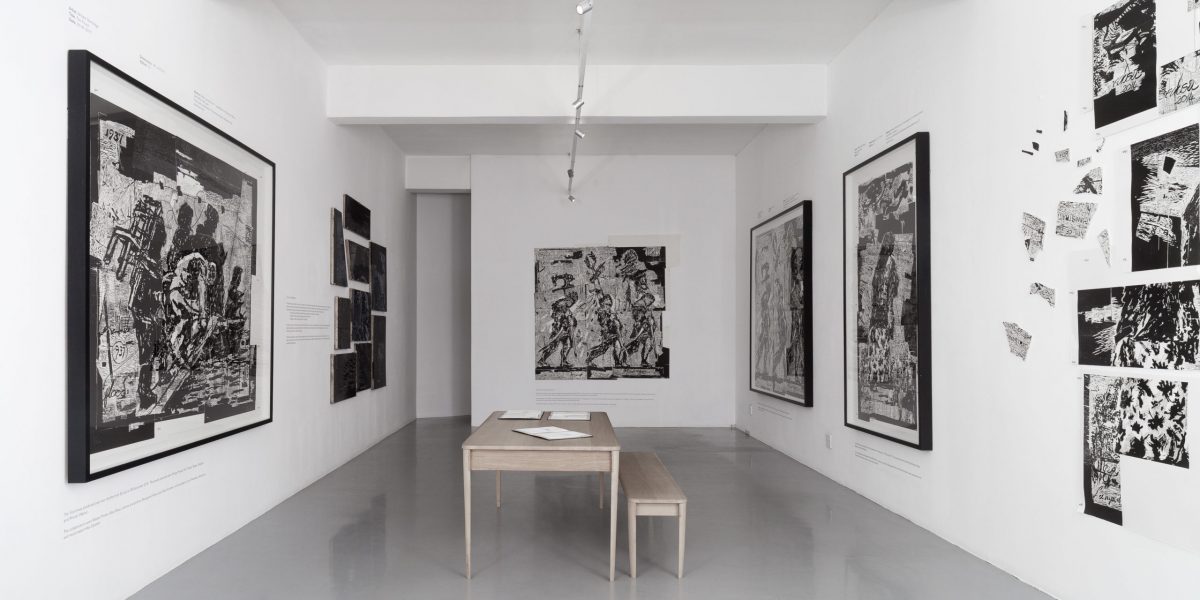

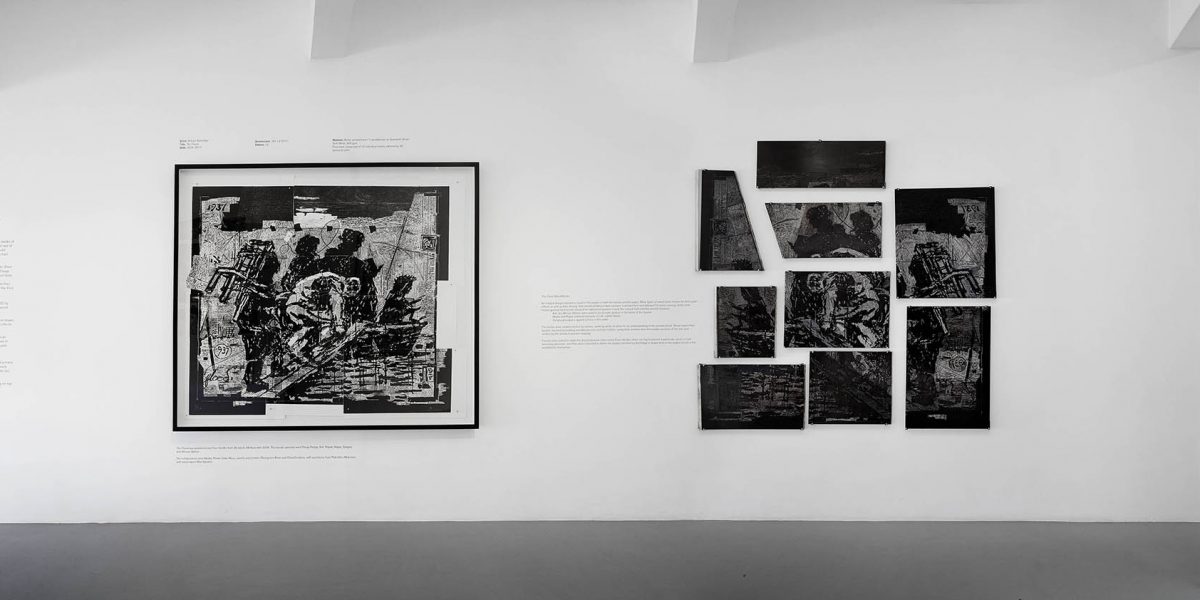
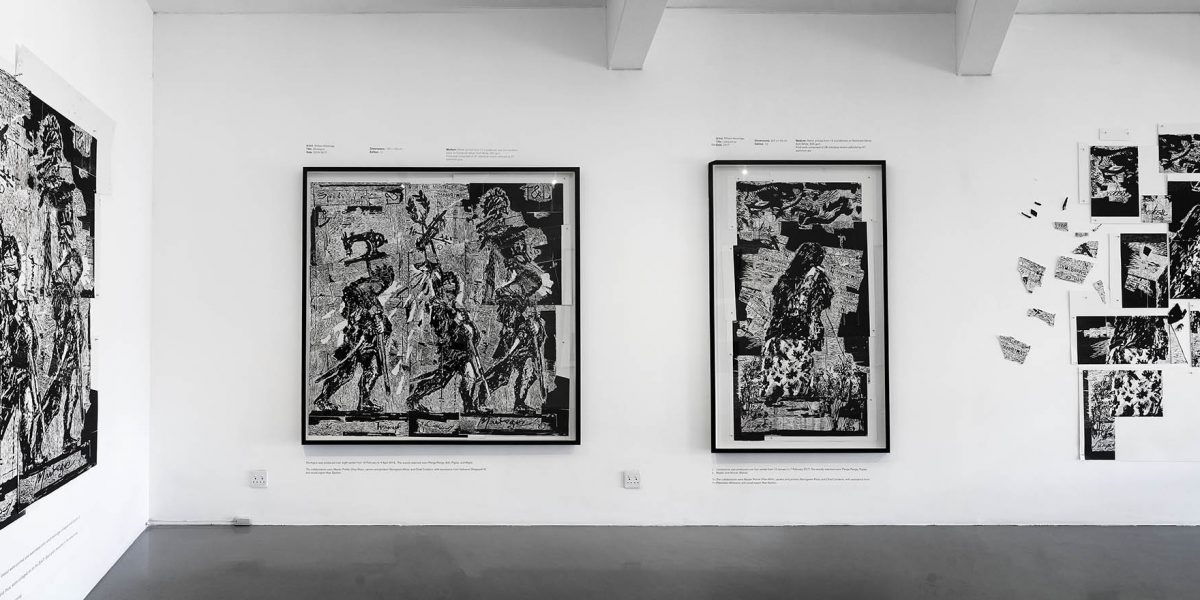
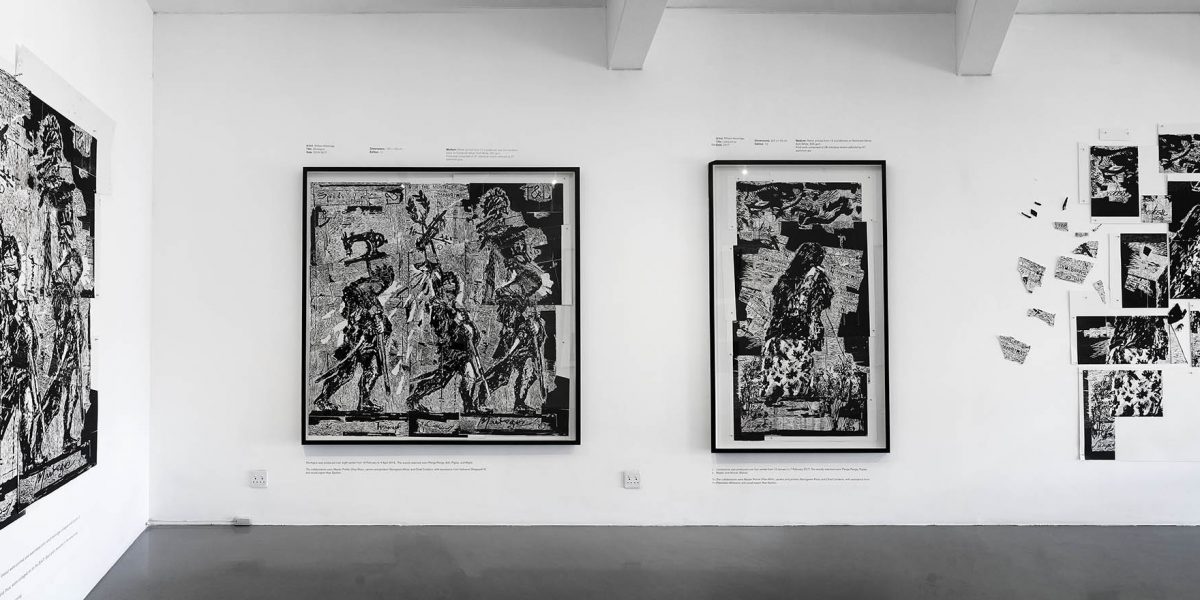
The Making of Triumphs and Laments Woodcuts, David Krut Projects, Johannesburg
July – August 2017
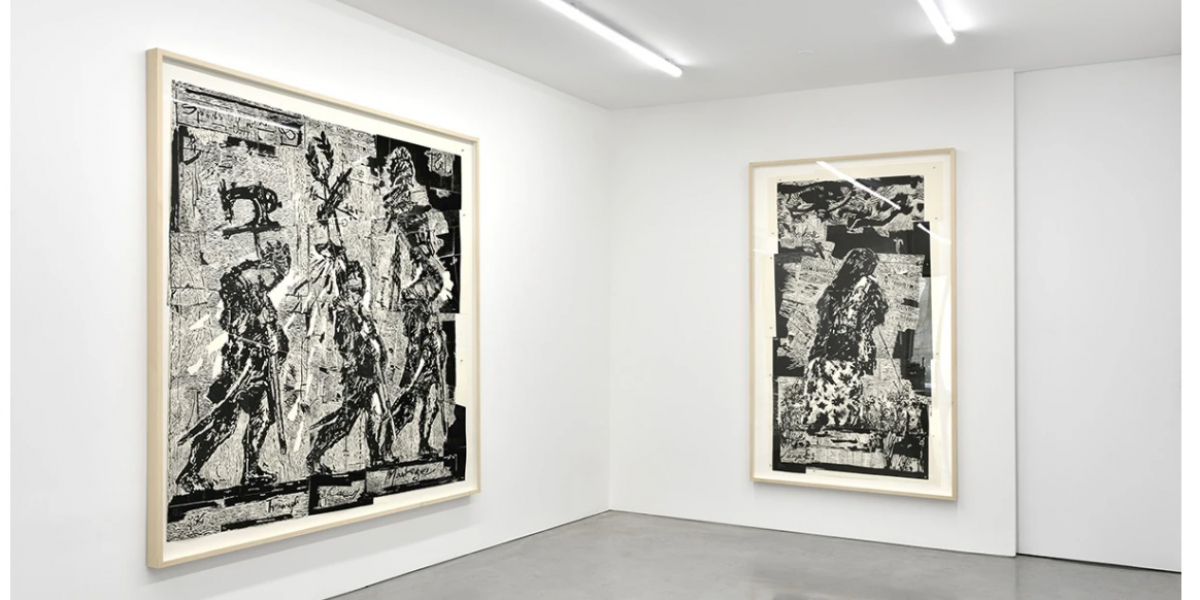
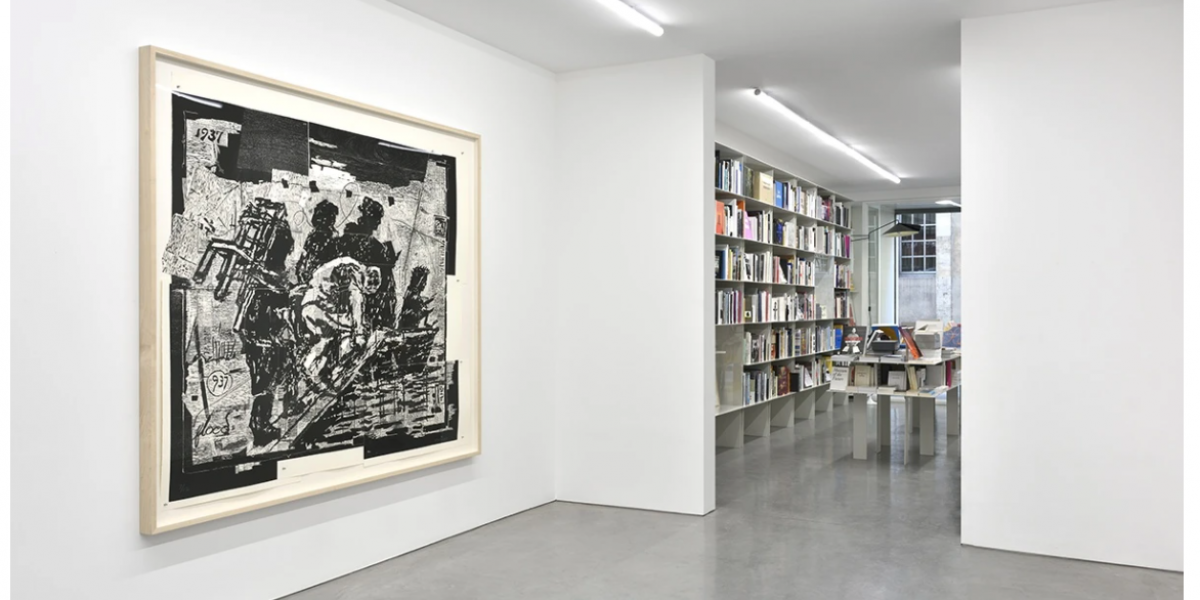

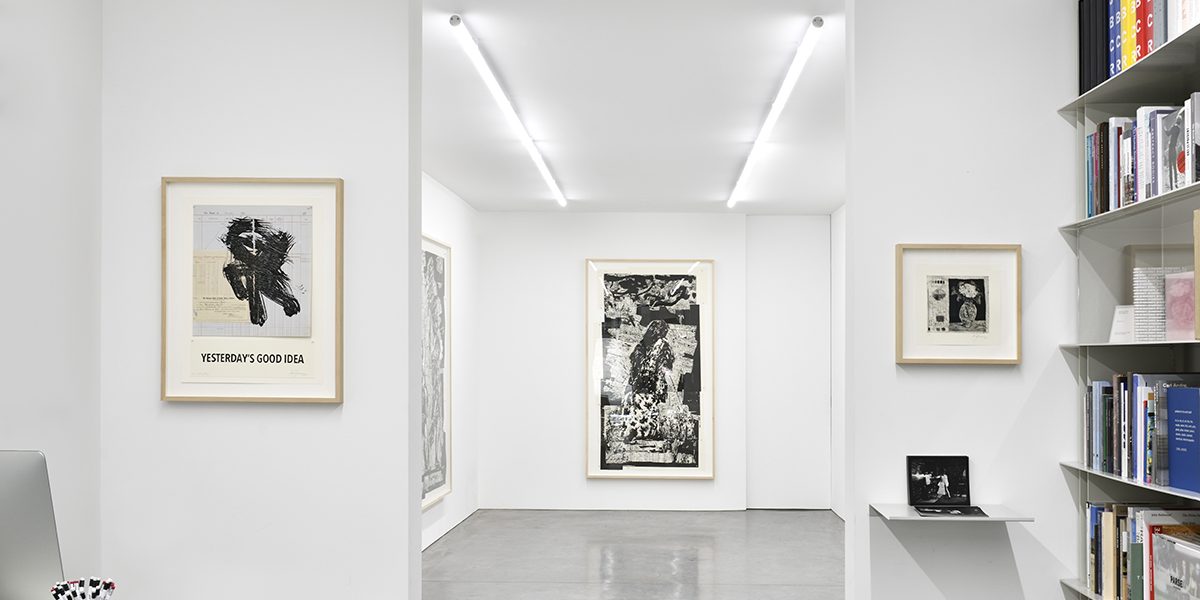
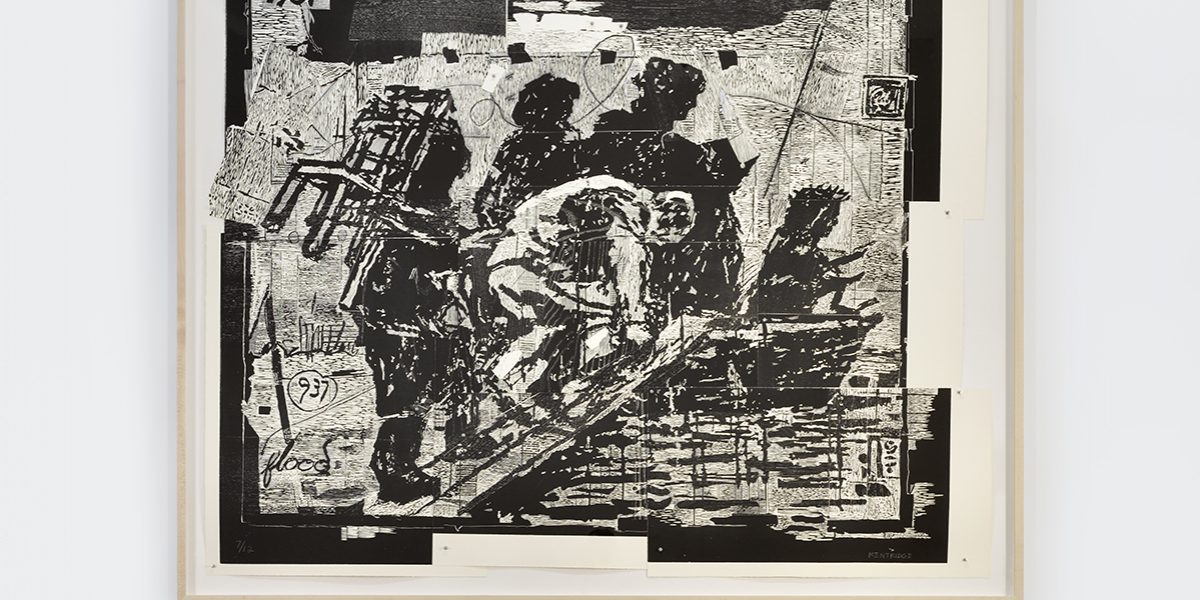
William Kentridge, O Sentimental Machine, Marian Goodman Gallery, Paris
March – May 2017

William Kentridge: Triumphs and Laments, Emerson Urban Arts Media Art Gallery, Boston
February – April 2018
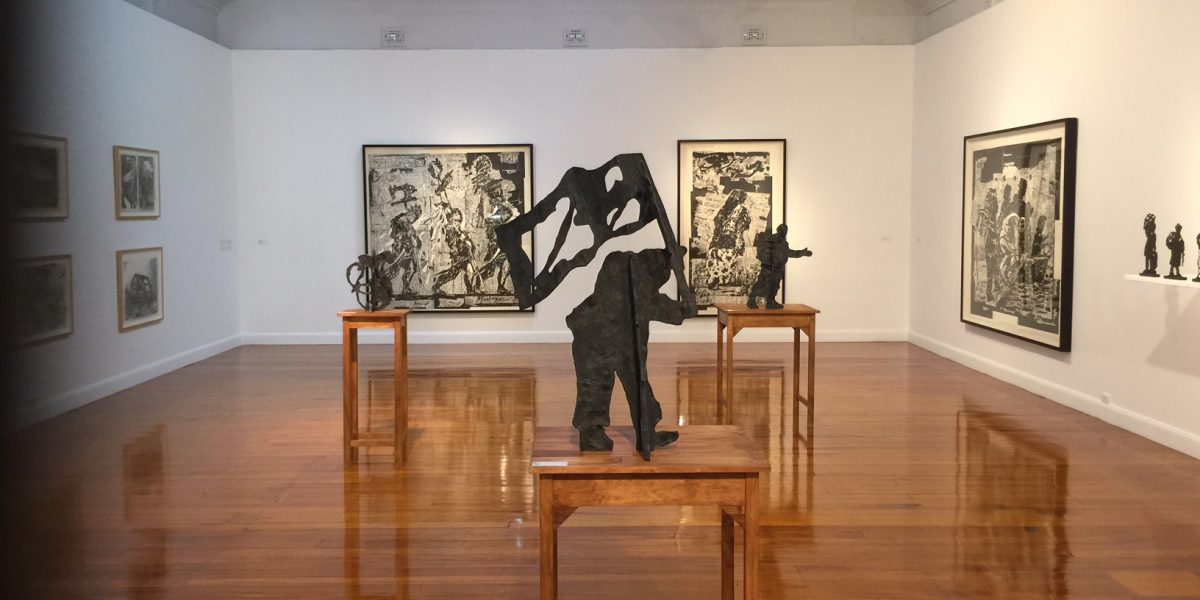
Right into her Arms, Annandale Gallery, Sydney
October – December 2018

Now and Later, Krakow Witkin Gallery, Boston
7 March – 4 April 2020
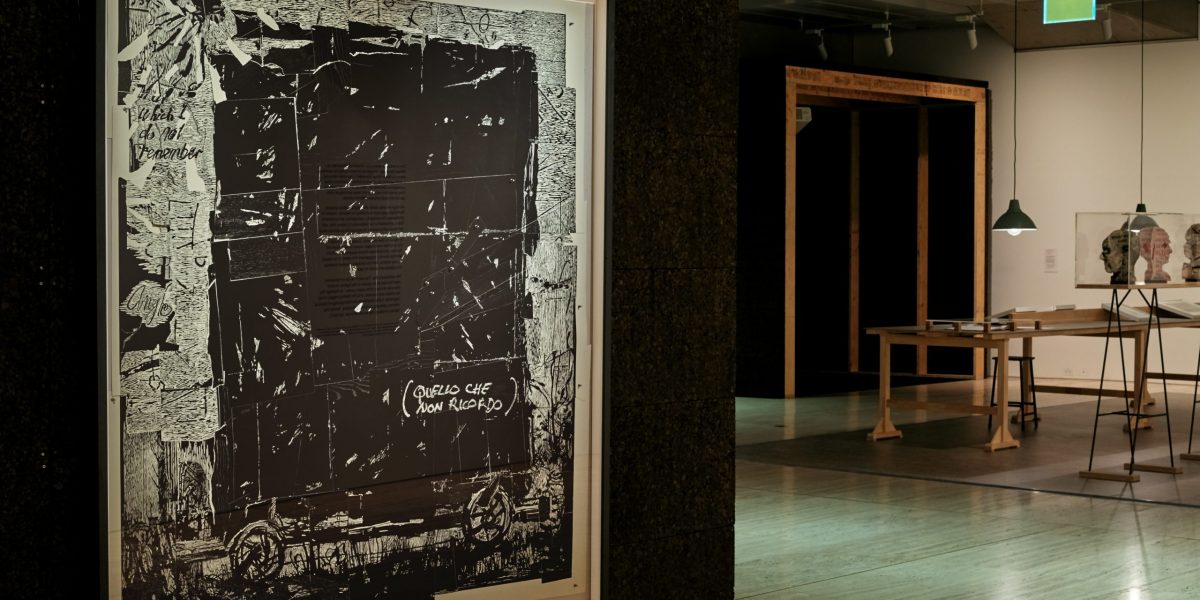
William Kentridge, That which we do not remember, Art Gallery of New South Wales, Sydney
Photography credit Christopher Snee Photo: © AGNSW
8 September 2018 – 3 February 2019
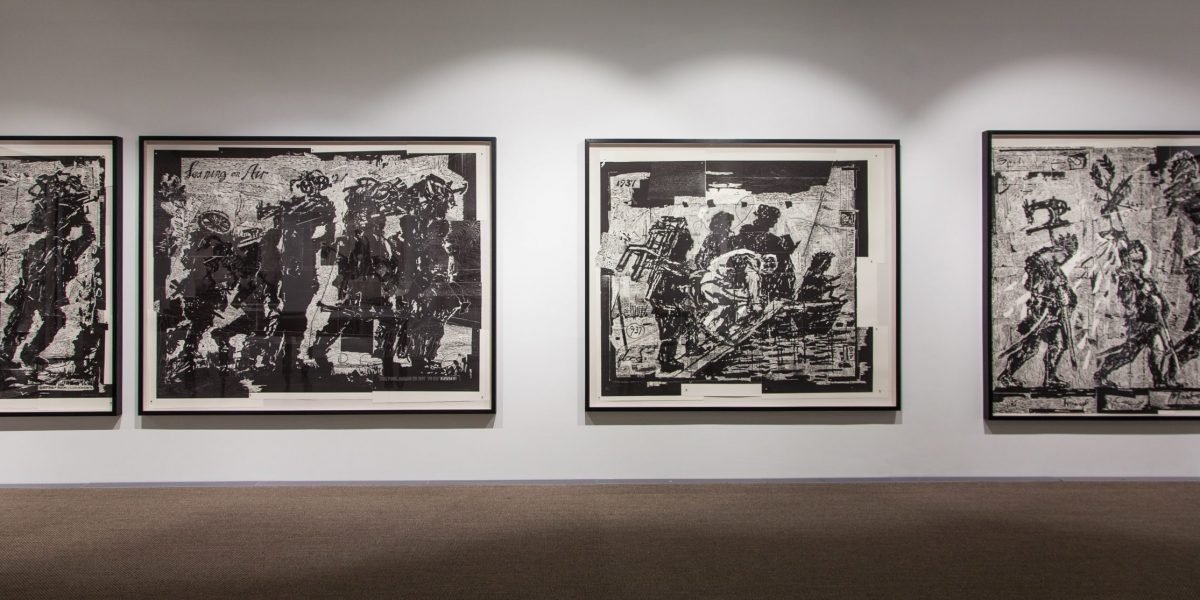
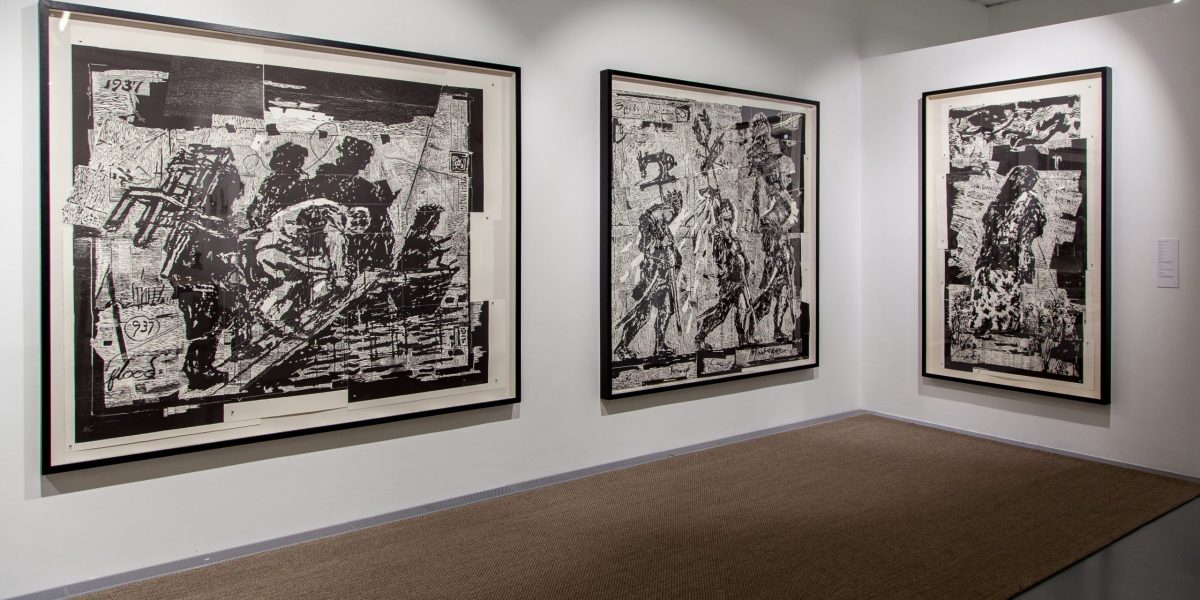
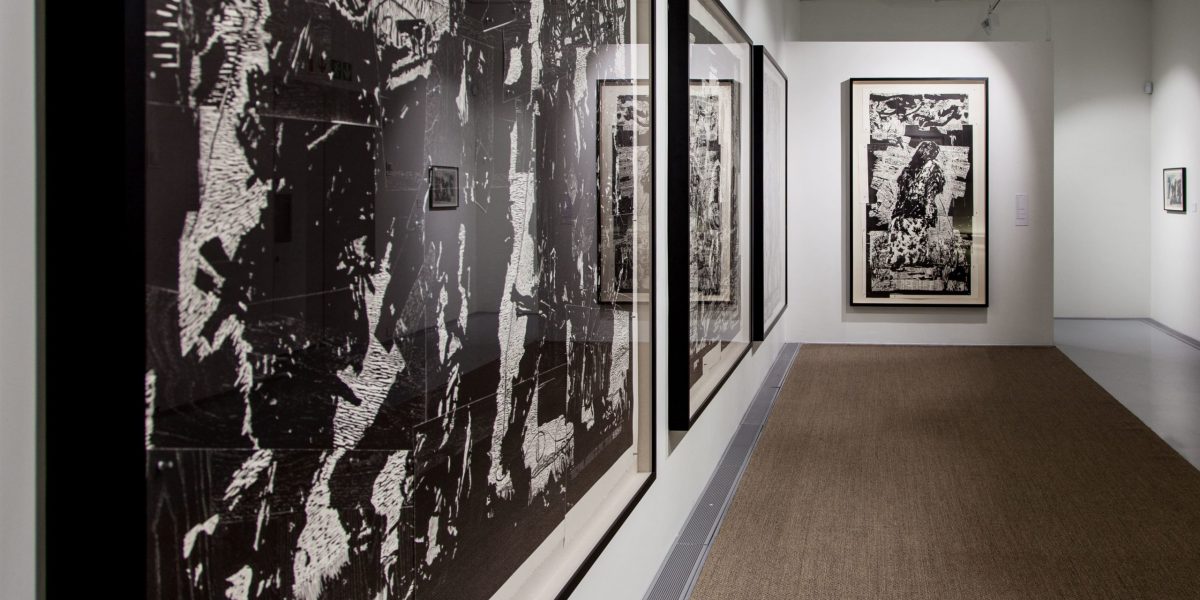

Why Should I Hesitate: Putting Drawings To Work, Zeitz Museum of Contemporary Art Africa, Cape Town
Photo credit Anel Wessels
25 August 2019 – 31 July 2020
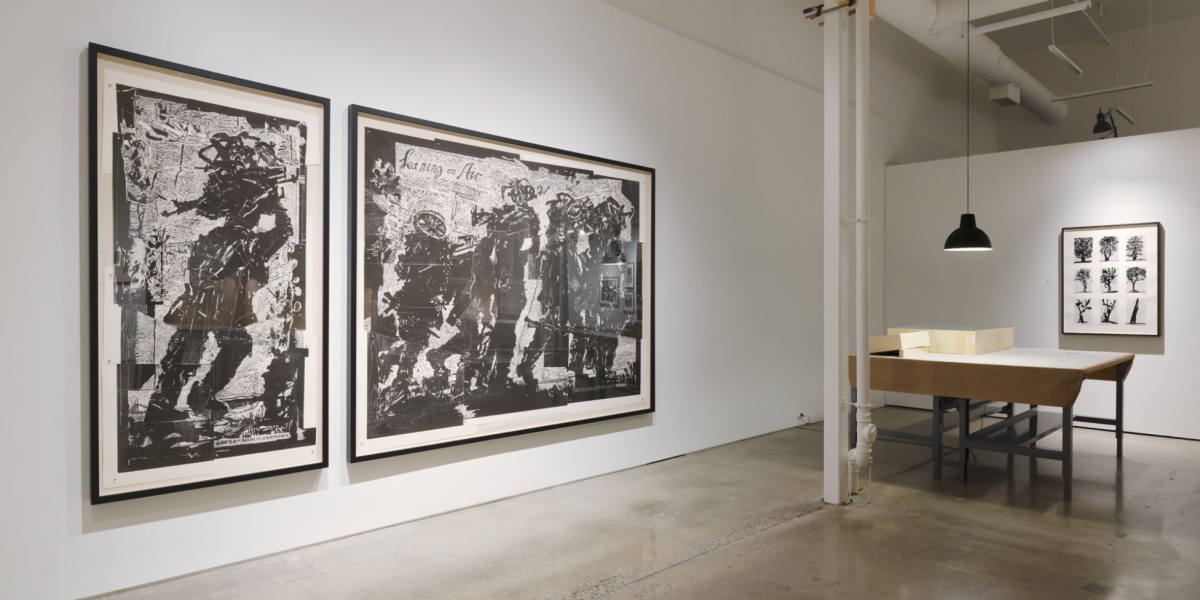
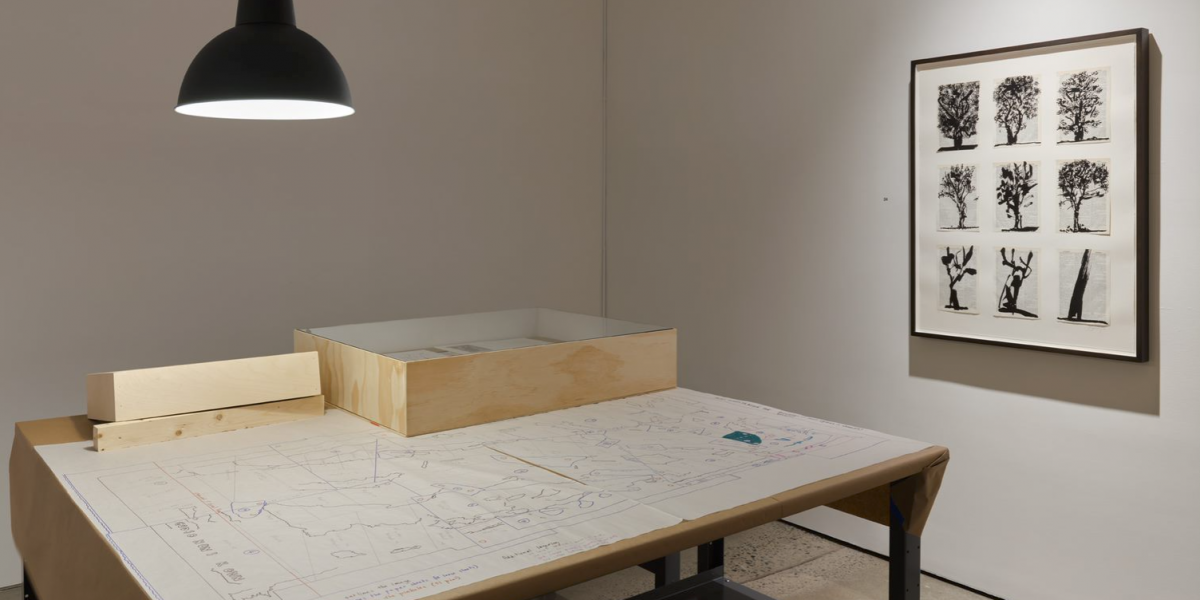
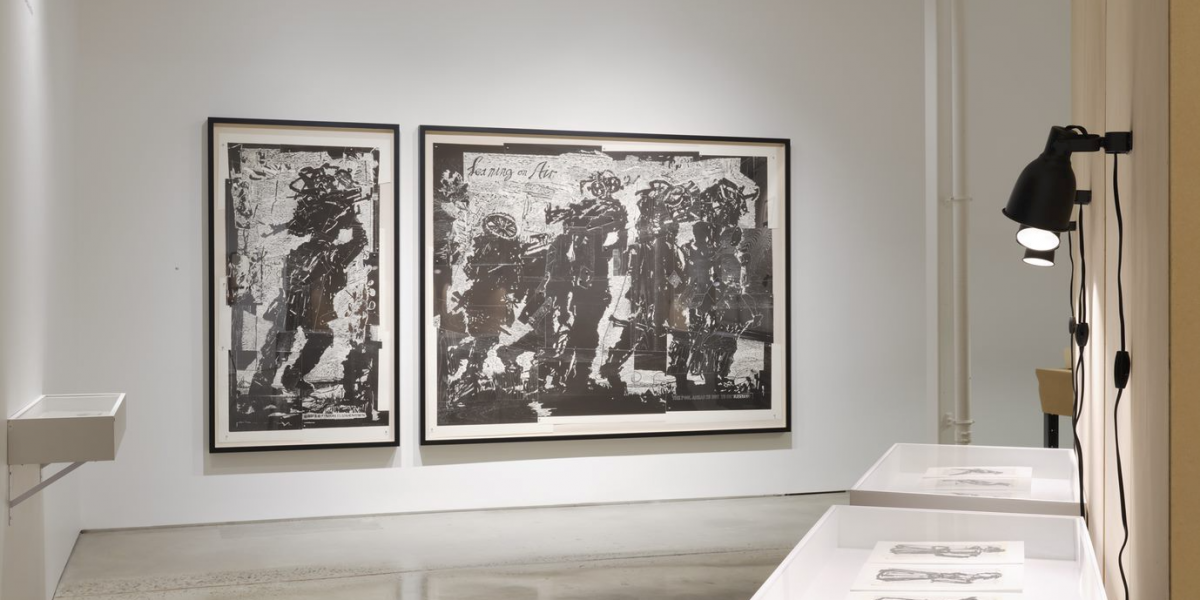
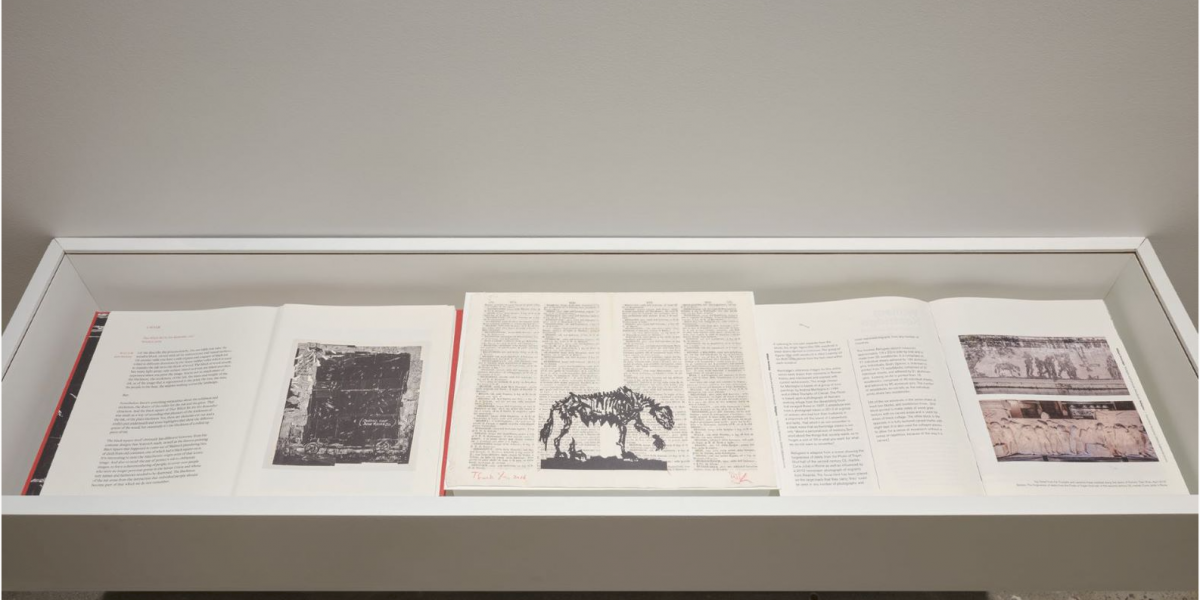
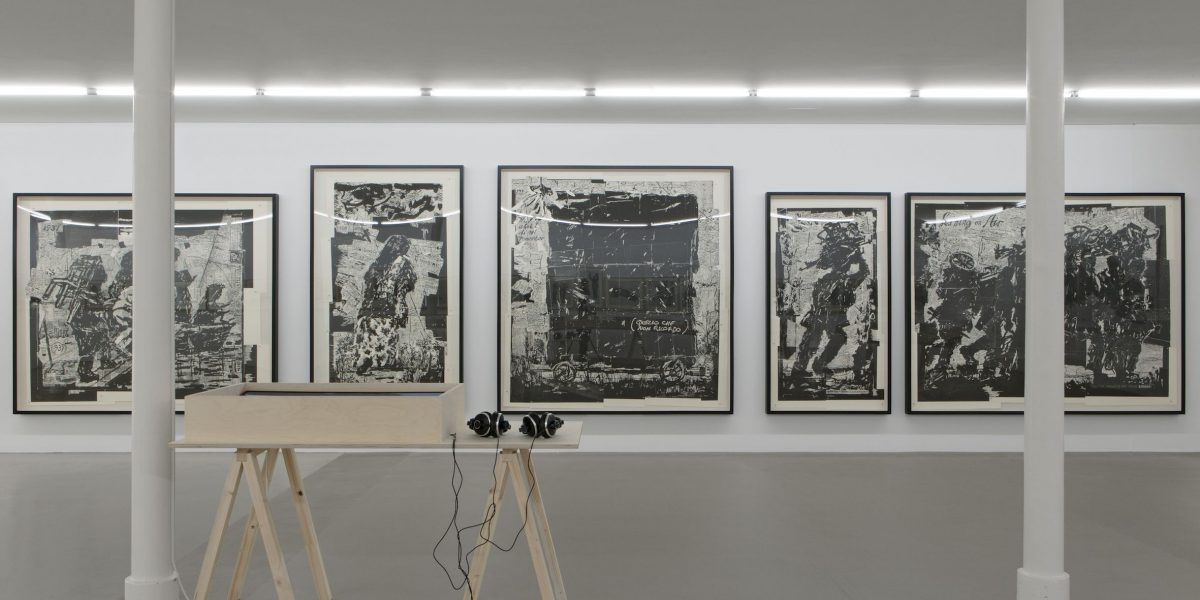
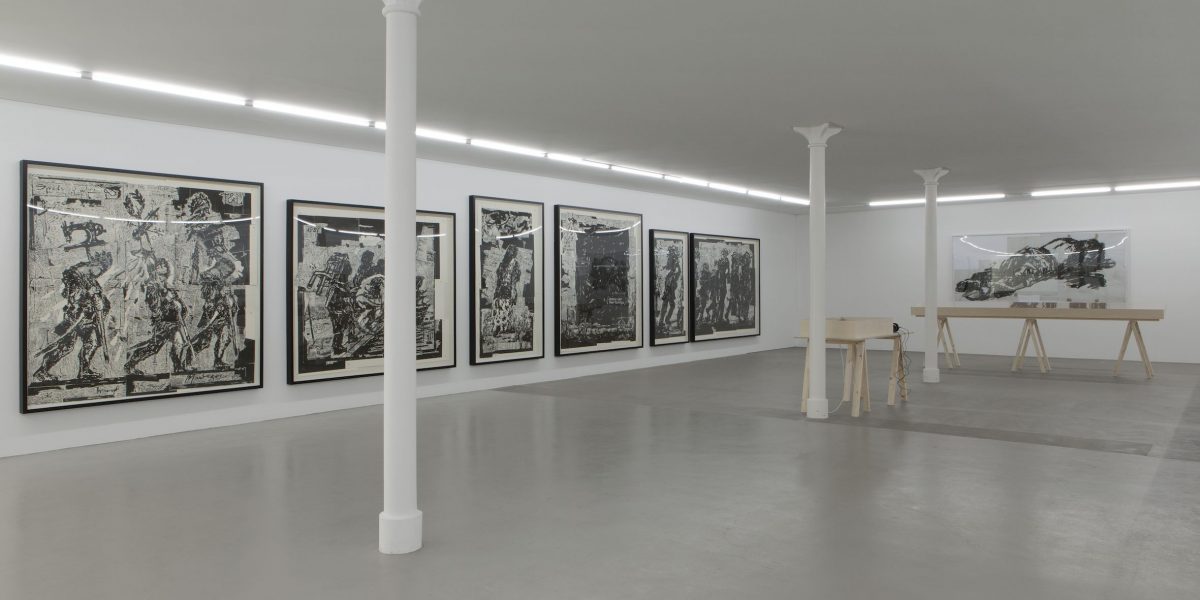
William Kentridge: A Poem That is Not Our Own, Kunstmuseum Basel, Switzerland
8 June – 13 October 2019




